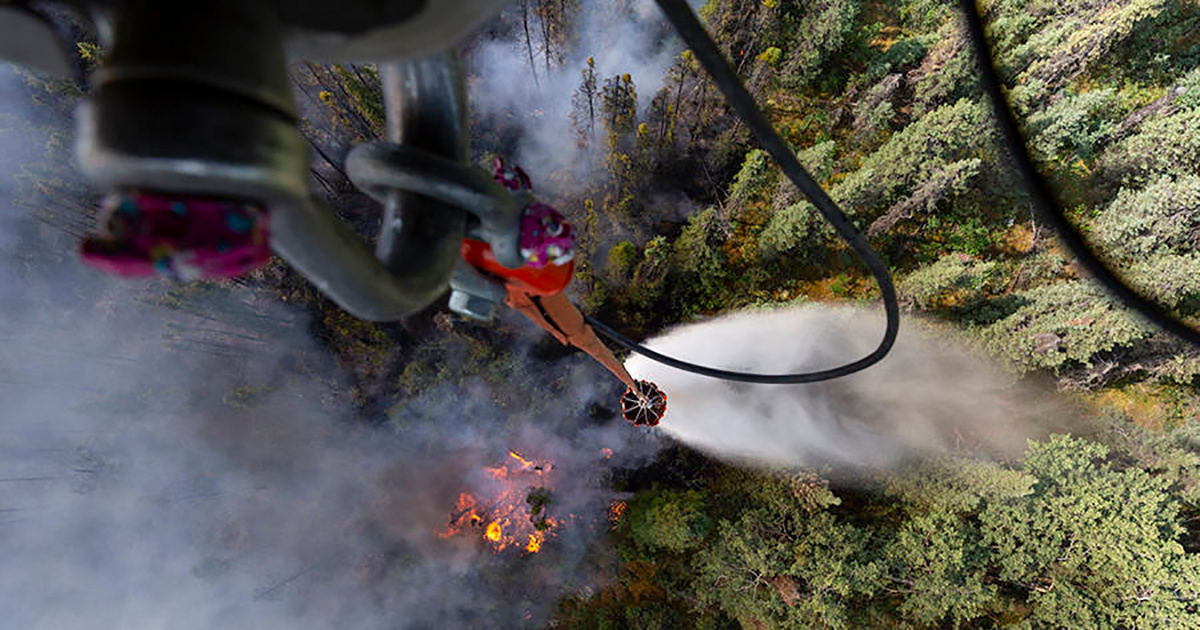
550,000 Acres on Fire in Alaska in Latest Sign of the Climate Crisis

Alaska Army National Guard helicopter crews fought a wildfire on July 4. Spc. Michael Risinger / U.S. Army National Guard
Two small communities near Anderson, Alaska were ordered to evacuate late Thursday due to a wildfire, as the state’s summer of heat and smoke continues.
The Kobe Fire was reported at 6:45 p.m. Thursday and by 10:50 p.m. had grown to 600 acres, The Alaska Division of Forestry reported. There are no reports that anyone was burned, but multiple buildings were threatened, prompting the evacuation of the Kobe and Anderson subdivisions. The residents of the City of Anderson, around 10 miles northeast of the blaze, were told to be ready to leave at a moment’s notice.
The fire is the latest to ignite in Alaska, where 1.2 million acres have burned so far this year, making 2019 one of the state’s three biggest wildfire years, according to InsideClimate News. Increasing Arctic wildfires have long been predicted in models of potential impacts of the climate crisis.
“When it comes to the Arctic heat wave, the wildfires, am I surprised? No — this was long predicted. Am I worried? Yes,” Pennsylvania State University climate scientist Michael Mann told InsideClimate News.
Alaska’s fires show the footprints of climate change in multiple ways. Higher temperatures are drying out the tundra and northern boreal forests. Alaska has experienced a record-breaking heat wave this spring and summer. The temperatures for the entire state for July 2018 to June 2019 averaged above freezing for the first time in 95 years, according to NOAA data.
For the first time in 95 years of record, @NOAANCEIclimate analysis puts the July-to-June average temperature for Alaska as a whole above freezing. Five of the ten warmest since 2014 and eight of ten warmest this century. #akwx #Arctic @Climatologist49 @IARC_Alaska @dougrbbns pic.twitter.com/AhOmwgUNzP
— Rick Thoman (@AlaskaWx) July 10, 2019
Climate change is also making lightning storms more likely, which were responsible for many of Alaska’s fires this year, International Arctic Research Center scientist Brian Brettschneider told InsideClimate News. Lightning sparked 12 new fires in the state on Wednesday alone, according to the Alaska Division of Forestry.
Lightning strikes spark dozen new wildfires in Southwest Alaska on Wednesday https://t.co/J90KSWhEVC pic.twitter.com/Kvq4HdbBZC
— AK Forestry (@AK_Forestry) July 12, 2019
On July 8, Alaska’s Hess Creek Fire was reported as the largest burning in the U.S. at 145,321 acres, according to Alaska Wildland Fire Information. The fire has been burning since June 21 in a part of central Alaska 80 miles north of Fairbanks, CNN reported.
“We’re all socked in with smoke,” firefighter spokesperson Sarah Wheeler told CNN. “It’s a smoky mess.”
#Alaska's #HessCreekFire is now the nation's largest #wildfire in 2019 – CNN https://t.co/Wr0JMNOkOG
— Janice Dash (@Trazlersgal) July 9, 2019
Currently, more than 550,000 of the 782,681 acres on fire in the U.S. are in Alaska, according to the National Interagency Coordination Center situation report. To put that in perspective, 505,900 acres burned in California in the state’s record wildfire year in 2017. However, fires in Alaska tend not to threaten human communities as often. Livengood, where the Hess Creek Fire is burning, only has a population of 13. Wheeler said some cabins were threatened by the flames, but most were not permanent homes.
“Alaskans are used to living with fire,” Wheeler told CNN.
- Anchorage, Alaska Hit 90 Degrees for First Time on July 4th ...
- The Arctic Is on Fire and Warming Twice as Fast as the Rest of the Earth - EcoWatch
- ‘Explosive’ Southern California Lake Fire Spreads to 10,000 Acres Within Hours - EcoWatch

 233k
233k  41k
41k  Subscribe
Subscribe 